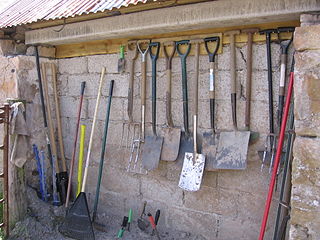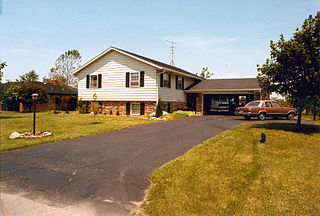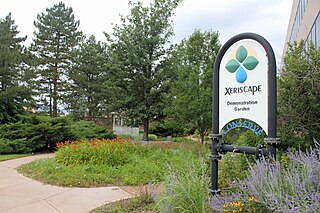Types
A wide range of hard landscape materials can be used, such as brick, gravel, rock or stone, concrete, timber, bitumen, glass, metals, etc.
Common gravel types include pea gravel and crushed granite gravel. [1]
'Hard landscape' can also describe outdoor furniture and other landscape products.
A mulch is a layer of material applied to the surface of soil. Reasons for applying mulch include conservation of soil moisture, improving fertility and health of the soil, reducing weed growth and enhancing the visual appeal of the area.

A patio is an outdoor space generally used for dining or recreation that adjoins a residence and is typically paved. In Australia the term is expanded to include roofed structures similar to a pergola, which provides protection from sun and rain.

Permeable paving is a method of paving vehicle and pedestrian pathways that allows for infiltration of fluids. In pavement design the base is the top portion of the roadway that pedestrians or vehicles come into contact with. The media used for the base of permeable paving may be porous, to allow for fluids to flow through it, or nonporous media that are spaced so that fluid may flow in between the gaps. In addition to reducing surface runoff, permeable paving can trap suspended solids therefore filtering pollutants from stormwater. Examples include roads, paths, and parking lots that are subject to light vehicular traffic, such as cycle-paths, service or emergency access lanes, road and airport shoulders, and residential sidewalks and driveways.

A bird bath is an artificial puddle or small shallow pond, created with a water-filled basin, in which birds may drink, bathe, and cool themselves. A bird bath can be a garden ornament, small reflecting pool, outdoor sculpture, and part of creating a vital wildlife garden.
Pavement, in construction, is an outdoor floor or superficial surface covering. Paving materials include asphalt, concrete, stones such as flagstone, cobblestone, and setts, artificial stone, bricks, tiles, and sometimes wood. In landscape architecture, pavements are part of the hardscape and are used on sidewalks, road surfaces, patios, courtyards, etc.

A flat roof is a roof which is almost level in contrast to the many types of sloped roofs. The slope of a roof is properly known as its pitch and flat roofs have up to approximately 10°. Flat roofs are an ancient form mostly used in arid climates and allow the roof space to be used as a living space or a living roof. Flat roofs, or "low-slope" roofs, are also commonly found on commercial buildings throughout the world. The National Roofing Contractors Association defines a low-slope roof as having a slope of 3-in-12 or less.

A garden tool is any one of many tools made for gardens and gardening and overlaps with the range of tools made for agriculture and horticulture. Garden tools can also be hand tools and power tools.
Sustainable landscape architecture is a category of sustainable design concerned with the planning and design of outdoor space.
An outdoor water-use restriction is a ban or other lesser restrictions put into effect that restricts the outdoor use of water supplies. Often called a watering ban or hosepipe ban, it can affect:

Natural landscaping, also called native gardening, is the use of native plants, including trees, shrubs, groundcover, and grasses which are indigenous to the geographic area of the garden.
Grading in civil engineering and landscape architectural construction is the work of ensuring a level base, or one with a specified slope, for a construction work such as a foundation, the base course for a road or a railway, or landscape and garden improvements, or surface drainage. The earthworks created for such a purpose are often called the sub-grade or finished contouring.

On a residential block of land, a front yard or front garden is the portion of land between the street and the front of the house. If it is covered in grass, it may be referred to as a front lawn. The area behind the house, usually more private, is the back yard or back garden. Yard and garden share an etymology and have overlapping meanings.
A specification often refers to a set of documented requirements to be satisfied by a material, design, product, or service. A specification is often a type of technical standard.

Crushed stone or angular rock is a form of construction aggregate, typically produced by mining a suitable rock deposit and breaking the removed rock down to the desired size using crushers. It is distinct from gravel which is produced by natural processes of weathering and erosion, and typically has a more rounded shape.

Xeriscaping is the process of landscaping or gardening that reduces or eliminates the need for supplemental water from irrigation. It is promoted in regions that do not have accessible, plentiful, or reliable supplies of fresh water, and is gaining acceptance in other regions as access to irrigation water is becoming limited. Xeriscaping may be an alternative to various types of traditional gardening.
Verde Pulgar is a software application concept that assists the user in understanding proper yard and garden maintenance. Intended to help homeowners and to assist qualified landscapers / gardeners in protecting and enhancing the appearances of yards and landscaping. Originally intended for use with the iPhone operating system, users will have access to the necessary tools that will better help them make correct decisions regarding the care for plants and lawns.

RentAGoat was founded in 2010 by 22-year-old entrepreneur Matthew Richmond, from Chapel Hill, North Carolina











